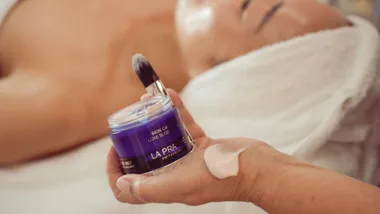With the over a year into a pandemic frequently putting professional beauty treatments out of our reach, it’s unsurprising that many of us are looking for skin-saving alternatives that we can do ourselves at home.
This is especially true where injectables like Botox are concerned, as the new regulations have eliminated the ability to keep up regular appointments.
And while you’ve likely stumbled across techniques like face massage and facial accupressure as a means to replace it, there is one at-home anti-ageing alternative to Botox you might not be acquainted with: face yoga.
Keep reading for a complete breakdown on the science, benefits and ‘how-to’ behind this free, DIY beauty method.
What Is Face Yoga?
As its name suggests, face yoga is essentially a ‘workout’ for your visage.
“Face yoga is a beauty routine utilising the practice of simple exercises designed to strengthen, tone, lift, and relax the facial muscles supporting the skin, which, if practised consistently, has been seen to promote a more youthful appearance,” explained Adie Robertson, face yoga expert and founder of wellness spa To Wonderland.
“Ageing contributes to a noticeable loss of volume in the face through a decreasing supply of fat cells, [as well as] a significantly reduced production of collagen and elastin and diminishing bone structure. At the same time the muscles of the face are shrinking, at worst atrophying, which collectively results in the skin being unsupported, and prone to sagging and wrinkles.
“This is where face yoga comes in. It exercises the muscles of the face, increases circulation of blood to the muscles and underlying tissue, thereby oxygenating the cells deep within to effectively detoxify and nourish the face at a deep level.”
What Are The Benefits Of Face Yoga?
Face yoga is said to offer a number of anti-ageing benefits, including but not limited to improved facial structure and a more plump visage.
“The result is a more sculpted face with voluminous muscle tone, which in turn improves facial structure (as yoga poses do for the body), creating a firmer, smoother and a more radiant appearance and a younger-looking face,” Robertson noted.
In fact, there is some evidence-based research to support the positive claims about face yoga’s anti-ageing benefits.
A study published in JAMA Dermatology in 2018 by Northwestern University examined 27 female participants between 40 and 65 who did 30 minutes of face yoga every day for eight weeks, then every other day for the remaining 16.
By the study’s completion, impartial dermatologists found the participants looked, on average, up to three years younger, after gauging a subtle yet important increase in cheek fullness.
“The primary mechanism is growth of the small muscles of the face, but it’s possible that a collagen boost may also occur,” Dr. Murad Alam, the vice chair of dermatology at Northwestern University, who led the study, told Goop.
“Any microtrauma—such as the mild irritation to the skin that facial exercise may cause—could result in the body laying down more collagen, making skin look more supple.”
It should be noted that while this research did indicate some positive outcomes, there aren’t many studies examining the benefits of face yoga, and the ones that have, were small and did not have control groups.
Does Face Yoga Actually Work?
Broadly speaking, some members of the medical community remain sceptical about whether face yoga actually works, particularly in the long-term. However, as it is a non-toxic and non-invasive technique for anti-ageing, many have deemed it worthy of further study and consider it safe to include in a home ‘practice’ beauty routine.
Having said that, dermatologists and face yoga practitioners alike warn against doing face yoga incorrectly, as it may actually encourage more wrinkles if performed improperly. This is because the act of performing face yoga goes against the widely accepted cause of wrinkles (excessive facial movement and expressions), so it needs to be practised correctly to avoid exacerbating the signs of ageing.
New York dermatologist Doris Day told Town & Country that it partially comes down to the direction in which the muscles move.
“I recommend facial exercises to be done every day. We exercise our face every time we make expressions, and most people overuse certain muscles which ends up weakening the opposing muscles,” she said.
“When you frown often enough to create a crease, you’re overusing those muscles and weakening the muscles that lift and smile, because you’re using those muscles less. Another rule is that muscles can only pull in one direction. So for every muscle pulling down, there’s an opposite/paired muscle that pulls up.”
Similarly, advocates of face yoga emphasise that its purpose is to relax the muscles, which ultimately smooths stress-filled expression lines and overly contorted muscles in what could be deemed a ‘natural facelift’, thereby preventing, or at least delaying, the onset of deep wrinkles.
“Relaxing the facial muscles, especially where we hold tension—like the jaw, brow, and forehead—can counteract the wrinkle-causing grimacing we do on a daily basis,” Annelise Hagen, a New York face yoga instructor and author of The Yoga Face: Eliminate Wrinkles with the Ultimate Natural Facelift told Total Beauty.
“Since the muscles on our faces can’t lift weights or go on the treadmill, when you apply pressure with your fingertips or make certain facial expressions, you’re toning and strengthening the muscles,” she said. “I would never say face yoga eradicates all lines, but it can definitely change the downward drift.”
Similarly, Robertson said she sees the results of face yoga in her spa all the time, and that, just like in yoga, the breath is an important element for yielding results.
“Using the combination of breath, muscle tension and deep relaxation as in a yoga practice [causes] the face to lose visible tension and naturally appear more relaxed, refreshed and youthful. [As] a witness to the transformation of faces before-and-after savasana], I know this to be so… it completely changes the look of someone’s face,” she said.
Lastly, face yoga is generally not recommended for women in their twenties and thirties. As the exercises are designed to increase the size of the muscles in the face, this could create a more ‘bulky’ effect in a younger visage that doesn’t require or desire the added volume.

How Do You Do Face Yoga At Home?
One of the great advantages of performing face yoga is that, as opposed to Botox, it’s completely free and can be done at home.
Like Botox, however, it can also be employed to treat different parts of the face.
Keep reading for three beginner face yoga workouts to tackle the eye area, complete visage and lower face (specifically, the ‘double chin’) by Karin Velikonja, face yoga instructor at Glowinface.
*Note: In each workout, it is recommended to hold every exercise for 30 seconds and repeat 3 times.*
Face Yoga Exercises For The Eye Area
Per Velikonja: “This exercise concentrates on the upper part of the face. It eliminates the wrinkles around the eyes, lifts the upper eyelids, and eliminates stalled lymph from the lower eyelid.”
How-to:
1. Put your palm ends onto the temples and embrace the head with your fingers.
2. Check in the mirror to see if palm ends cover the end of your eyebrows – they have to!
3. Press into the muscle with your palms first, and then press backward and up.
4. Close and squint your eyes intensely until you feel your muscle below working.
5. Your neck, shoulders and other facial muscles must be relaxed.
Face Yoga Exercises For A ‘Total Facelift’
“This face yoga exercise rejuvenates, lifts, and tones all 57 muscles on the face and neck. It reduces wrinkles on the face, neck, and décolletage. The best time to implement this exercise in your routine is in the morning, because it boosts your energy, wakes you up and clears your mind,” Velikonja explained on her website.
How-to:
1. Make long and narrow “O” with your mouth, then hold for a few seconds.
2. Then pull your upper and lower lip inwards over your teeth firmly and hold it.
3. Hold the chin with your finger to keep your “O” long and narrow
4. Then lift your cheeks from the corners of your mouth like you would like to smile.
5. Be careful not to create wrinkles around the eyes. To prevent that, you can place your fingers on the temples, then press into the muscles and up.
Face Yoga Exercises To Reduce A Double Chin
According to Velikonja, this workout “firms and tones the muscle groups in around and under the chin. It helps to raise the sagging cheeks and strengthens the entire jaw. It also reduces wrinkles on both sides of the chin, the so-called ‘bags’, it eliminates the double chin and smooths the skin on the neck.”
How-to:
1. Smile, open your mouth and make an “aaaa” sound.
2. Put your lower lip and corners over your lower teeth and press it inward.
3. Start pushing your jaw outwards—as far as it goes and try to lift the cheeks.
4. You must feel the resistance between your cheeks pulling up and your jaw pushing out.
5. When your jawbone can’t get any further, cover the area around the mouth with two fingers on both sides to prevent wrinkles and hold.










